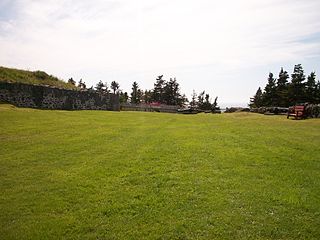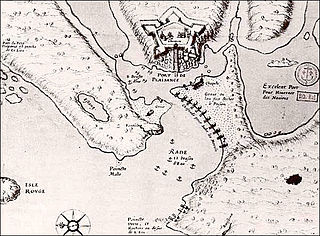
Events from the year 1704 in Canada.

Events from the year 1706 in Canada.

Events from the year 1712 in Canada.

Events from the year 1713 in Canada.

Placentia is a town located in the Canadian province of Newfoundland and Labrador. It consists of the Argentia Industrial Park and amalgamated communities of Townside, Freshwater, Dunville, Southeast, Point Verde and Jerseyside.
Louis Armand, Baron de Lahontan (9 June 1666 – prior to 1716) served in the French military in Canada where he traveled extensively in the Wisconsin and Minnesota region and the upper Mississippi Valley. Upon his return to Europe he wrote an enormously popular travelogue. In it he recounted his voyage up the "Long River," now thought to be the Missouri. He wrote at length and in very positive terms about Native American culture, portraying Indian people as free, rational, and generally admirable.

Île-Royale was a French colony in North America that existed from 1713 to 1763 It consisted of two islands, Île Royale and Île Saint-Jean. It was ceded to the British Empire after the Seven Years' War, and is today part of Canada.

Philippe Pastour de Costebelle was a naval officer and Governor of Newfoundland and then Louisbourg. He was born in Languedoc and died in Louisbourg.
Jacques-François de Monbeton de Brouillan French military officer and Governor of Plaisance (Placentia), Newfoundland (1689-1701) and Acadia (1701-1705).
Louis de Pastour de Costebelle naval officer served as interim governor of Plaisance (Placentia), Newfoundland, before the arrival of Jacques-François de Monbeton de Brouillan in 1690. Costebelle came to Newfoundland as head of a detachment of soldiers in 1687.
Claude Barrat was a notary and a clerk of the court in Placentia (Plaisance), Newfoundland.

Castle Hill is an area containing the remains of both French and British fortifications, overlooking the town of Placentia in Newfoundland and Labrador, Canada. The site was originally established in order to protect the French fishing interests in Newfoundland and the approaches to the French colony of Canada.

The Newfoundland expedition was a naval raiding expedition led by English Captain John Leake between August and October 1702 that targeted French colonial settlements on the North Atlantic island of Newfoundland and its satellite Saint Pierre. The expedition occurred in the early days of Queen Anne's War, as the North American theater of the War of the Spanish Succession is sometimes known.

The Battle of St. John's was the French capture of St. John's, the capital of the British colony of Newfoundland, on 1 January 1709 [O.S. 21 December 1708], during Queen Anne's War. A mixed and motley force of 164 men led by Joseph de Monbeton de Brouillan de Saint-Ovide, king's lieutenant to Philippe Pastour de Costebelle, the French governor of Plaisance, quickly overwhelmed the British garrison at St. John's, and took about 500 prisoners.
Pierre Maisonnat dit Baptiste was a French privateer famous for the success he had against New England merchant shipping and fishing interests during King William's War and Queen Anne's War. Baptiste's crew members were primarily Acadians.

The siege of St. John's was a failed attempt by French forces led by Daniel d'Auger de Subercase to take the fort at St. John's, Newfoundland during the winter months of 1705, in Queen Anne's War. Leading a mixed force of regulars, militia, and Indians, Subercase burned much of the town and laid an ineffectual siege against the fort for five weeks between late January and early March 1705. Subercase lifted the siege after running out of provisions and gunpowder.

Fort Royal is a French fort built in 1687 on the island of Newfoundland during the time of New France.

The Avalon Peninsula campaign occurred during King William's War when forces of New France, led by Pierre Le Moyne d'Iberville and Governor Jacques-François de Monbeton de Brouillan, destroyed 23 English settlements along the coast of the Avalon Peninsula, Newfoundland in the span of three months. The campaign began with raiding Ferryland on November 10, 1696, and continued along the coast until they raided the village of Heart's Content

Fort Saint Louis was a French fort built in the 17th century on the island of Newfoundland at the time of the New France.

Fort Plaisance was a French fort built in the 17th century on the island of Newfoundland at the time of the New France.










